2003 PONTIAC BONNEVILLE service
[x] Cancel search: servicePage 326 of 418
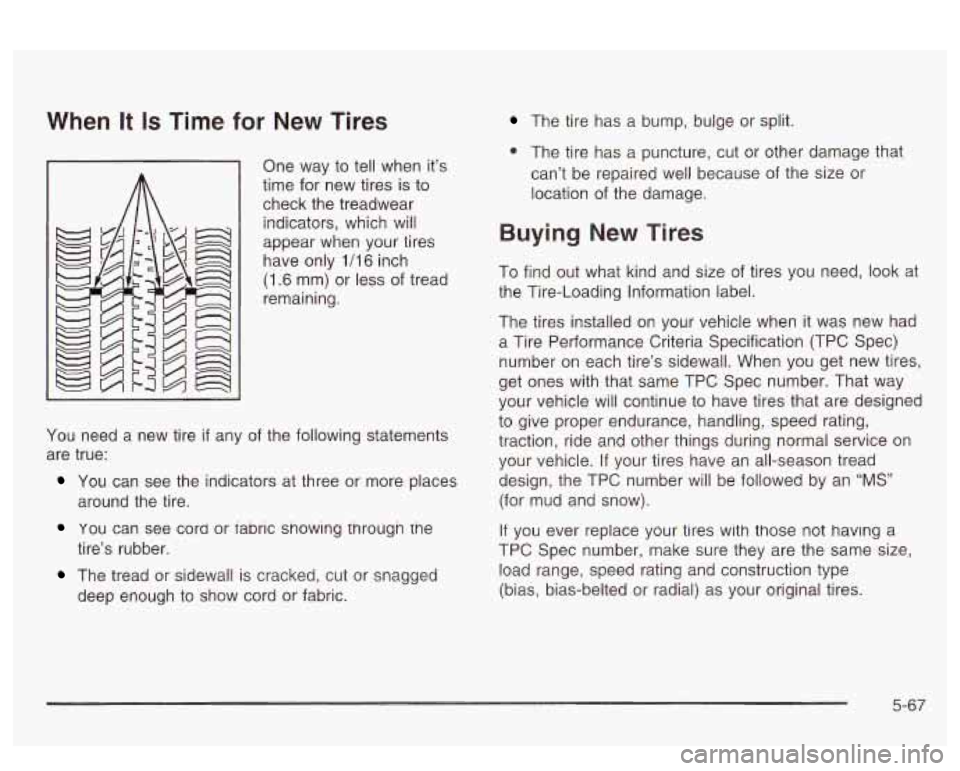
When It Is Time for New Tires
One way to tell when it’s
time for new tires
is to
check the treadwear
indicators, which will
appear when your tires
have only 1/16 inch
(1.6 mm) or less of tread
remaining.
You need a new tire
if any of the following statements
are true:
You can see the indicators at three or more places
YOU can see cord or tabric snowing tnrougn tne
around the tire.
tire’s rubber.
The tread or sidewall is cracked, cut or snagged
deep enough to show cord or fabric.
The tire has a bump, bulge or split.
b The tire has a puncture, cut or other damage that
can’t be repaired well because of the size or
location of the damage.
Buying New Tires
To find out what kind and size of tires you need, look at
the Tire-Loading Information label.
The tires installed on your vehicle when it was new had
a Tire Performance Criteria Specification (TPC Spec)
number on each tire’s sidewall. When you get new tires,
get ones with that same TPC Spec number. That way
your vehicle will continue to have tires that are designed
to give proper endurance, handling, speed rating,
traction, ride and other things during normal service on
your vehicle.
If your tires have an all-season tread
design, the TPC number will be followed by an
“MS”
(for mud and snow).
If you ever replace your tires with those not having a
TPC Spec number, make sure they are the same size,
load range, speed rating and construction type
(bias, bias-belted or radial) as your original tires.
5-67
Page 328 of 418
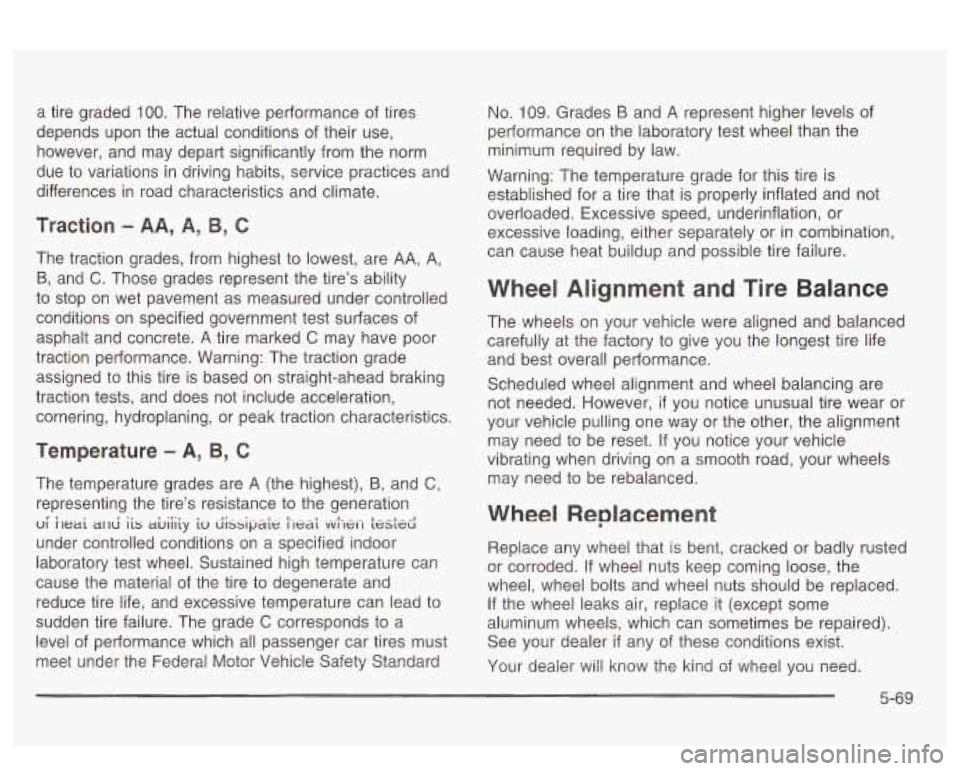
a tire graded 100. The relative performance of tires
depends upon the actual conditions of their use,
however, and may depart significantly from the norm
due to variations in driving habits, service practices and
differences in road characteristics and climate.
Traction - AA, A, B, C
The traction grades, from highest to lowest, are AA, A,
B, and C. Those grades represent the tire’s ability
to stop on wet pavement as measured under controlled
conditions on specified government test surfaces
of
asphalt and concrete. A tire marked C may have poor
traction performance. Warning: The traction grade
assigned to this tire is based on straight-ahead braking
traction tests, and does not include acceleration,
cornering, hydroplaning, or peak traction characteristics.
Temperature - A, B, C
The temperature grades are A (the highest), B, and C,
representing the tire’s resistance to the generation
under controlled conditions on a specified indoor
laboratory
test wheel. Sustained high temperature can
cause the material of the tire to degenerate and
reduce tire life, and excessive temperature can lead to
sudden tire failure. The grade
C corresponds to a
level of performance which all passenger car tires must
meet under the Federal Motor Vehicle Safety Standard
ui ireai ar~d iis aLiiiiy iu dissip& i-ledf vvi-Iei-1 t&&
No. 109. Grades B and A represent higher levels of
performance on the laboratory test wheel than the
minimum required by law.
Warning: The temperature grade for this tire
is
established for a tire that is properly inflated and not
overloaded. Excessive speed, underinflation, or
excessive loading, either separately or in combination,
can cause heat buildup and possible tire failure.
Wheel Alignment and Tire Balance
The wheels on your vehicle were aligned and balanced
carefully at the factory to give you the longest tire life
and best overall performance.
Scheduled wheel alignment and wheel balancing are
not needed. However,
if you notice unusual tire wear or
your vehicle pulling one way or the other, the alignment
may need to be reset. If you notice your vehicle
vibrating when driving on a smooth road, your wheels
may need
to be rebalanced.
Wheel Replacement
Replace any wheel that is bent, cracked or badly rusted
or corroded.
If wheel nuts keep coming loose, the
wheel, wheel bolts and wheel nuts should be replaced.
If the wheel leaks air, replace it (except some
aluminum wheels, which can sometimes be repaired).
See your dealer
if any of these conditions exist.
Your dealer will know the kind of wheel you need.
5-69
Page 346 of 418
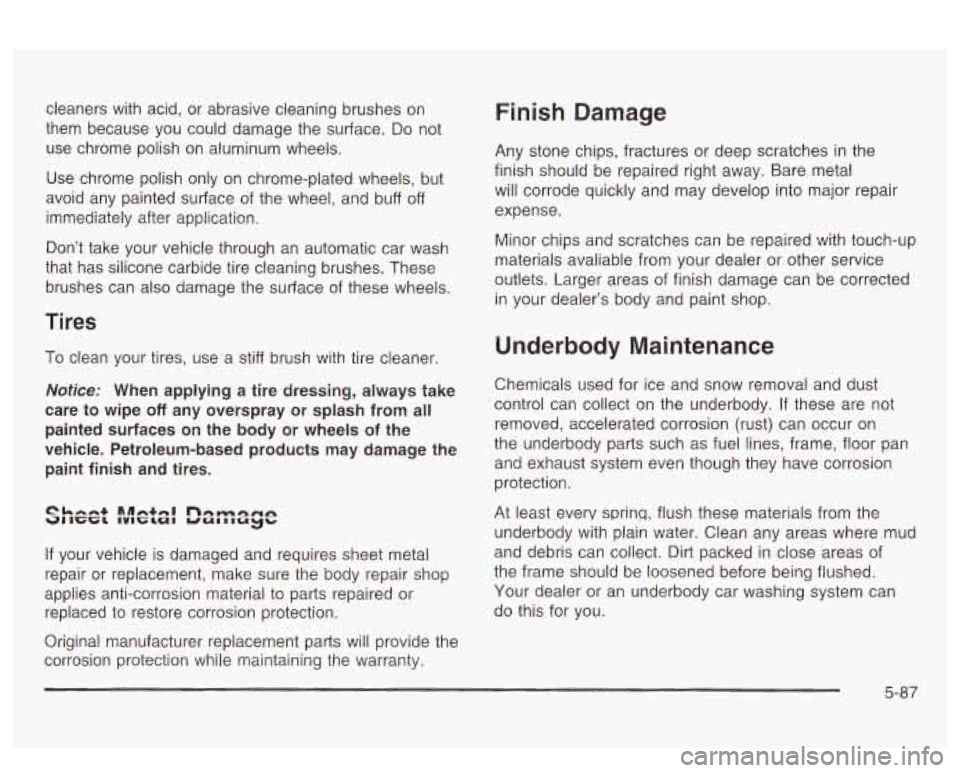
cleaners with acid, or abrasive cleaning brushes on
them because you could damage the surface.
Do not
use chrome polish on aluminum wheels.
Use chrome polish only on chrome-plated wheels, but
avoid any painted surface of the wheel, and buff off
immediately after application.
Don’t take your vehicle through an automatic car wash
that has silicone carbide tire cleaning brushes. These
brushes can also damage the surface of these wheels.
Tires
To clean your tires, use a stiff brush with tire cleaner.
Nofice: When applying a tire dressing, always take
care to wipe off any overspray or splash from all
painted surfaces
on the body or wheels of the
vehicle. Petroleum-based products may damage the
paint finish and tires.
If your vehicle is damaged and requires sheet metal
repair or replacement, make sure the body repair shop
applies anti-corrosion material to parts repaired or
replaced to restore corrosion protection.
Finish Damage
Any stone chips, fractures or deep scratches in the
finish should be repaired right away. Bare metal
will corrode quickly and may develop into major repair
expense.
Minor chips and scratches can be repaired with touch-up
materials avaliable from your dealer or other service
outlets. Larger areas of finish damage can be corrected
in your dealer’s body and paint shop.
Underbody Maintenance
Chemicals used for ice and snow removal and dust
control can collect on the underbody.
If these are not
removed, accelerated corrosion (rust) can occur on
the underbody parts such as fuel lines, frame, floor pan
and exhaust system even though they have corrosion
protection.
At least everv sprinq, flush these materials from the
underbody with plain water. Clean any areas where mud
and debris can collect. Dirt packed
in close areas of
the frame should be loosened before being flushed.
Your dealer or an underbody car washing system can
do this for you.
Original manufacturer replacement parts will provide the
corrosion protection while maintaining the warranty.
5-a7
Page 349 of 418
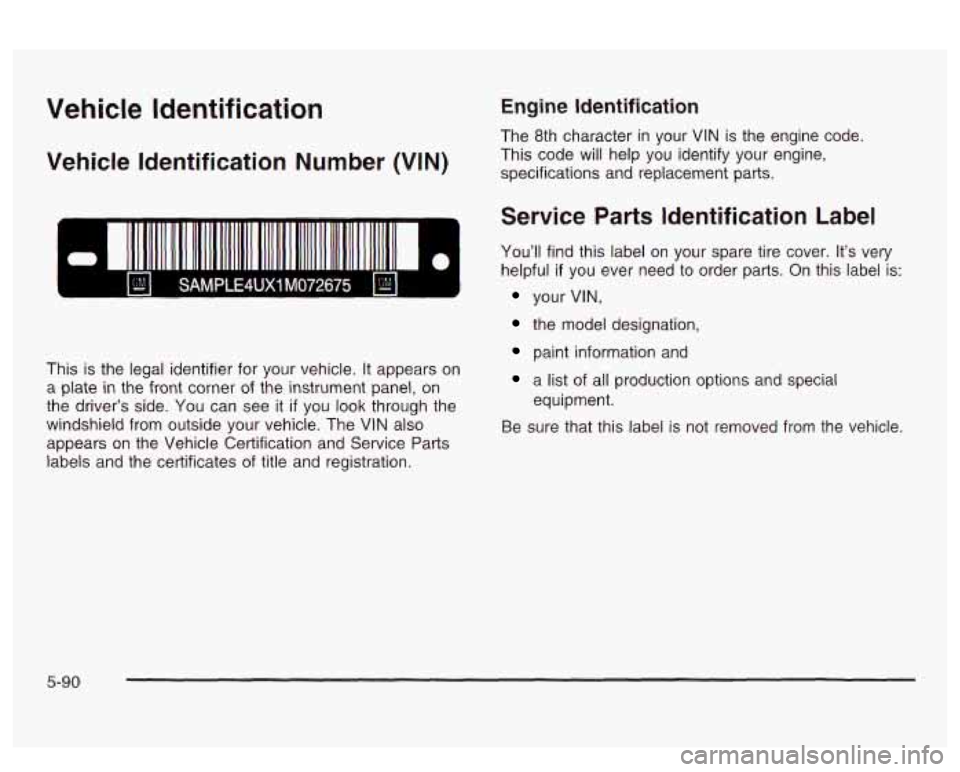
Vehicle Identification
Vehicle Identification Number (VIN)
SAMPLE4UXl M072675 1
This is the legal identifier for your vehicle. It appears on
a plate in the front corner of the instrument panel, on
the driver’s side. You can see it
if you look through the
windshield from outside your vehicle. The VIN also
appears on the Vehicle Certification
and Service Parts
labels and the certificates of title and registration.
Engine Identification
The 8th character in your VIN is the engine code.
This code will help you identify your engine,
specifications and replacement parts.
Service Parts Identification Label
You’ll find this label on your spare tire cover. It’s very
helpful if you ever need to order parts. On this label is:
your VIN,
the model designation,
paint information and
a list of all production options and special
equipment.
Be sure that this label
is not removed from the vehicle.
5-90
Page 351 of 418
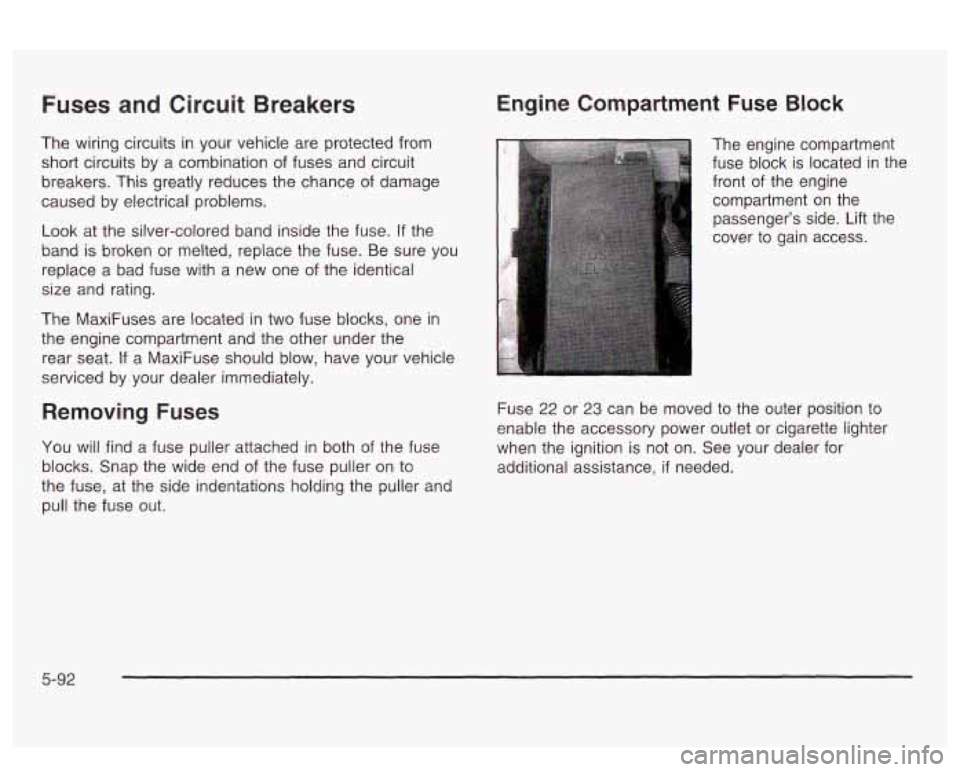
Fuses and Circuit Breakers
The wiring circuits in your vehicle are protected from
short circuits by a combination of fuses and circuit
breakers. This greatly reduces the chance of damage
caused by electrical problems.
Look at the silver-colored band inside the fuse.
If the
band is broken or melted, replace the fuse. Be sure you
replace a bad fuse with a new one of the identical
size and rating.
The MaxiFuses are located in
two fuse blocks, one in
the engine compartment and the other under the
rear seat. If a MaxiFuse should blow, have your vehicle
serviced by your dealer immediately.
Removing Fuses
You will find a fuse puller attached in both of the fuse
blocks. Snap the wide end of the fuse puller on
to
the fuse, at the side indentations holding the puller and
pull the fuse
out.
Engine Compartment Fuse Block
The engine compartment
fuse block is located in the
front
of the engine
compartment on the
passenger’s side. Lift the
cover
to gain access.
Fuse
22 or 23 can be moved to the outer position to
enable the accessory power outlet or cigarette lighter
when the ignition is not on. See your dealer for
additional assistance,
if needed.
5-92
Page 362 of 418
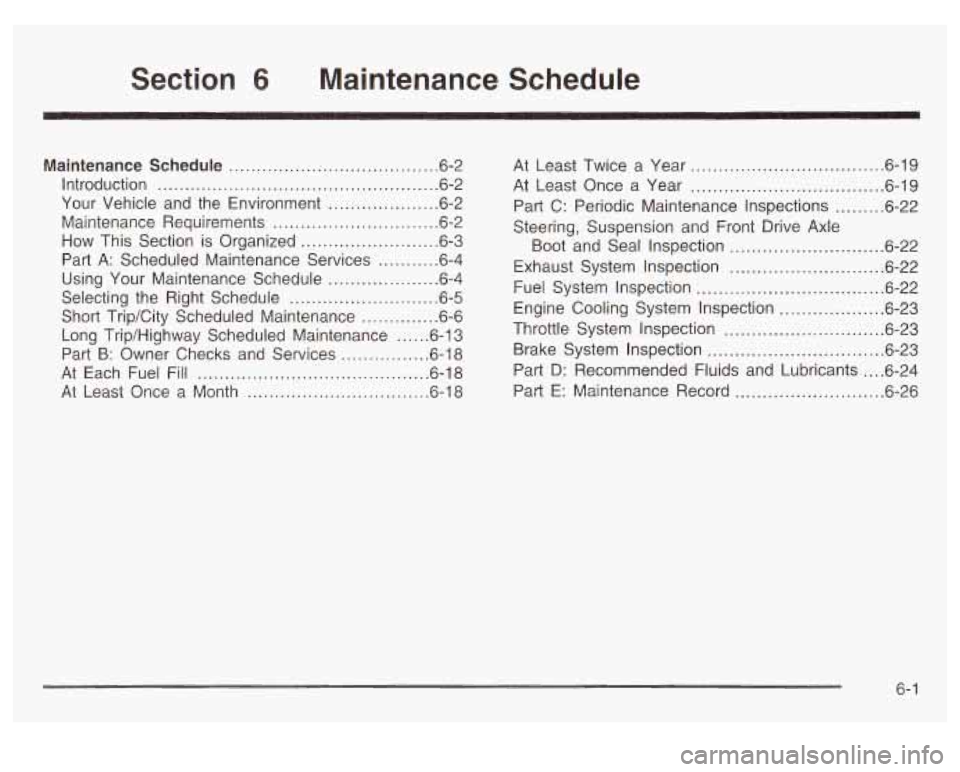
6 Maintenance Schedule
Maintenance Schedule ...................................... 6.2
Introduction
................................................... 6.2
Your Vehicle and the Environment
.................... 6-2
Maintenance Requirements
.......................... 6.2
How This Section is Organized
..................... 6-3
Selecting the Right Schedule
........................... 6-5
Part
A: Scheduled Maintenance Services
........... 6.4
Using Your Maintenance Schedule
.................... 6-4
Short Trip/City Scheduled Maintenance
.............. 6-6
Long Trip/Highway Scheduled Maintenance
...... 6-13
Part
B: Owner Checks and Services ................ 6-18
At Each Fuel Fill
.......................................... 6-18
At Least Once a Month 0- IO P 40 .................................
At Least Twice a Year ................................... 6.19
At Least Once a Year
................................... 6.19
Part C: Periodic Maintenance Inspections
......... 6.22
Steering, Suspension and Front Drive Axle
Boot and Seal Inspection
............................ 6-22
Exhaust System Inspection
........................... -6-22
Fuel System Inspection
.................................. 6-22
Engine Cooling System Inspection
................... 6-23
Throttle System Inspection
............................. 6-23
Brake System Inspection
................................ 6-23
Part
D: Recommended Fluids and Lubricants .... 6-24
Part
E: Maintenance Record ........................... 6-26
6- 1
Page 364 of 418
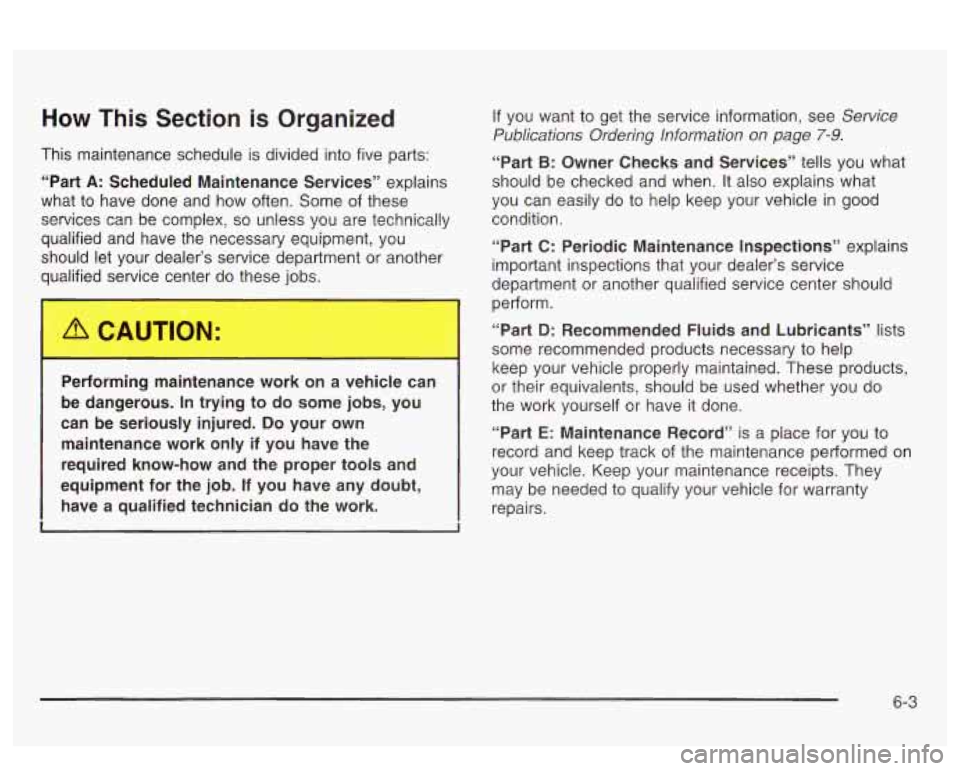
How This Section is Organized
This maintenance schedule is divided into five parts:
“Part
A: Scheduled Maintenance Services” explains
what to have done and how often. Some of these
services can be complex,
so unless you are technically
qualified and have the necessary equipment, you
should let your dealer’s service department or another
qualified service center do these jobs.
If you want to get the service information, see Service
Publications Ordering Information on page
7-9.
“Part B: Owner Checks and Services” tells you what
should be checked and when. It also explains what
you can easily do to help keep your vehicle in good
condition.
“Part C: Periodic Maintenance Inspections” explains
important inspections that your dealer’s service
department or another qualified service center should
petform.
Performing maintenance work on a vehicle can
be dangerous. In trying to do some jobs, you
can be seriously injured.
Do your own
maintenance work only if you have the
required know-how and the proper tools and
equipment for the job.
If you have any doubt,
have a qualified technician
do the work.
I
“Part D: Recommended Fluids and Lubricants” lists
some recommended products necessary
to help
keep your vehicle properly maintained. These products,
or their equivalents, should be used whether you do
the work yourself or have it done.
“Part E: Maintenance Record” is a place for you to
record and keep track of the maintenance performed on
your vehicle. Keep your maintenance receipts. They
may be needed to qualify your vehicle for warranty
repairs.
6-3
Page 365 of 418
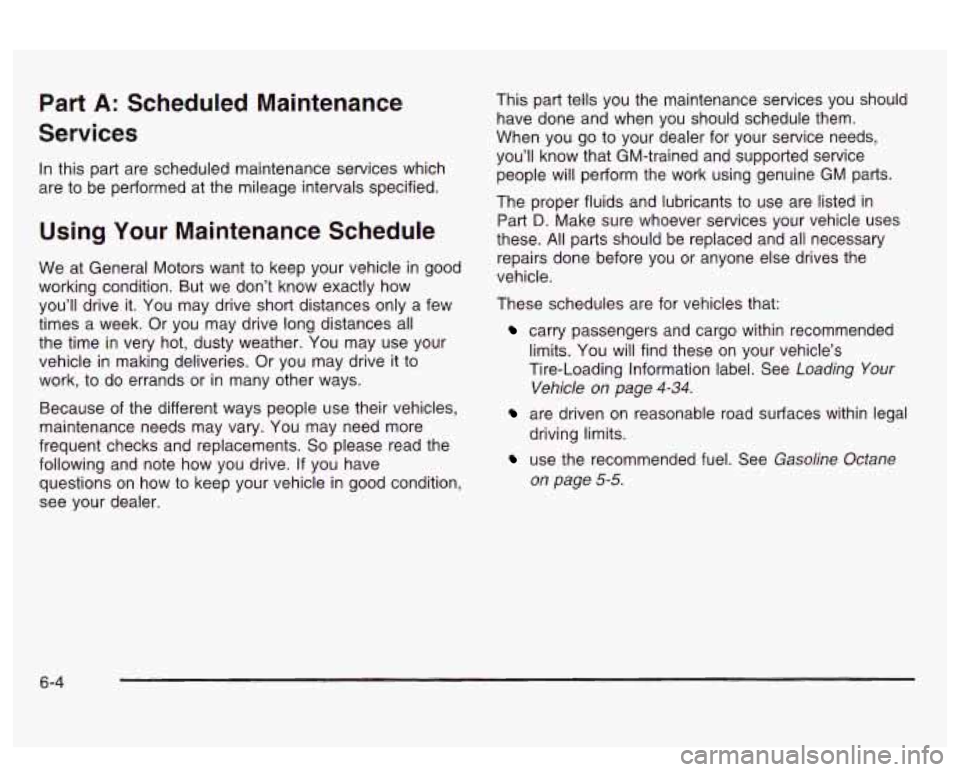
Part A: Scheduled Maintenance
Services
In this part are scheduled maintenance services which
are to be performed at the mileage intervals specified.
Using Your Maintenance Schedule
We at General Motors want to keep your vehicle in good
working condition. But we don’t know exactly how
you’ll drive it. You may drive short distances only a few
times a week. Or you may drive long distances all
the time in very hot, dusty weather. You may use your
vehicle in making deliveries. Or you may drive it to
work, to do errands or in many other ways.
Because of the different ways people use their vehicles,
maintenance needs may vary. You may need more
frequent checks and replacements. So please read the
following and note how you drive.
If you have
questions on how to keep your vehicle in good condition,
see your dealer. This part tells you the
maintenance services you should
have done and when you should schedule them.
When you go to your dealer for your service needs,
you’ll know that GM-trained and supported service
people will perform the work using genuine GM parts.
The proper fluids and lubricants to use are listed in
Part
D. Make sure whoever services your vehicle uses
these.
All parts should be replaced and all necessary
repairs done before you or anyone else drives the
vehicle.
These schedules are for vehicles that:
carry passengers and cargo within recommended
limits. You will find these on your vehicle’s
Tire-Loading Information label. See
Loading Your
Vehicle on page 4-34.
are driven on reasonable road surfaces within legal
use the recommended fuel. See Gasoline Octane
driving limits.
on page 5-5.
6-4